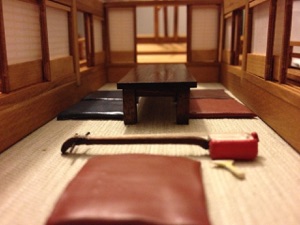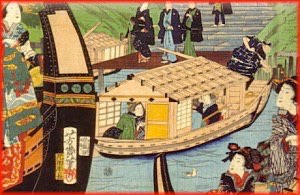Yakatabune, Japanese Edo Period HOUSEBoat


About the Model
This model was based on a kit from Woody Joe of Japan. It is a 1/24-scale model, so a person would be just over 2-1/2” tall. The 2’ long model is primarily made from Hinoki (Hee-Noh-Key) or Japanese Cypress, and is constructed in common ship modeling style, over an internal framework.
This model features a basic tatami room interior behind the sliding shoji screen panels. The room features a traditional low table called a Zataku, surrounded by floor pillows, called Zabuton. For this model, I made a tiny 3-string instrument called a Shamisen, along with a plectrum used to pluck the strings.
The coloring of the exterior of the model I based upon images of the boats as they appeared in Japanese woodblock prints of the time.
Those interested in Japanese style boats should check out the website of American boatbuilder Douglas Brooks, who has studied in Japan and apprenticed with five traditional Japanese boat builders and has written articles and one book on the subject.
To purchase the Yakatabune kit, I recommend the Japanese international hobby dealer Zootoyz.jp. Be aware that the instructions are written completely in Japanese. But, there is heavy use of illustration, and it is a relatively simple kit.
View Model Construction Photo Gallery
Yakatabune, Japanese Edo Period Houseboat
The Yakatabune (Yah-Kah-Tah-Boo-Ney) is the name for a pleasure boat that was originally used by nobility as a way to entertain guests, relax, or perhaps view cherry blossoms along the rivers or lakes of Japan. In the Edo Period, rising economic prosperity made this craft accessible to commoners and it became popular, particularly among Japan’s rising merchant class.
The passengers could sit inside the deck house and drink tea or sake and perhaps listen to music played by a hired entertainer. In urban areas, there were often food houses along the river that could provide them with hot food. On warm days, the passengers might sit on the open deck or on the roof of the deck house where they could enjoy the scenery.
The yakatabune were usually operated by one or more boatmen who operated the sculling oar at the stern or used long bamboo poles to push along the bottom or the shore.
Today, yakatabune still symbolize a time of prosperity and simple pleasures. Large, modern, motorized versions serve as floating restaurants today, while some smaller yakatabune can occasionally be found on lakes in Japan, catering to tourist
The Yakatabune is a small houseboat that became popular in Edo Period Japan and symbolizes the rise in disposable income and leisure time in pre-modern Japan.
This is a 1/24 scale model built from a kit from Japanese model manufacturer Woody Joe. The model measures about 6-1/2” tall and just over 2‘ long.


